Polyatomic groups - Study guides, Class notes & Summaries
Looking for the best study guides, study notes and summaries about Polyatomic groups? On this page you'll find 143 study documents about Polyatomic groups.
Page 3 out of 143 results
Sort by
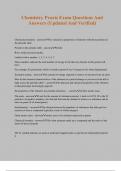
-
Chemistry Praxis Exam Questions And Answers (Updated And Verified)
- Exam (elaborations) • 7 pages • 2024
-
- $11.49
- + learn more
Chemistry Praxis Exam Questions And Answers (Updated And Verified) Chemical periodicity - answerThe variation in properties of elements with their positions in the periodic table Periods in the periodic table - answerPeriods: Rows which run horizontally. Labeled with a number: 1, 2, 3, 4, 5, 6, 7. These numbers indicate the total number of energy levels that any element in this period will have. For example, K (potassium) which is found in period 4, has 4 energy levels when diagrammed. ...
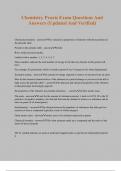
-
Chemistry Praxis Exam Questions And Answers (Updated And Verified)
- Exam (elaborations) • 7 pages • 2024
-
- $11.49
- + learn more
Chemistry Praxis Exam Questions And Answers (Updated And Verified) Chemical periodicity - answerThe variation in properties of elements with their positions in the periodic table Periods in the periodic table - answerPeriods: Rows which run horizontally. Labeled with a number: 1, 2, 3, 4, 5, 6, 7. These numbers indicate the total number of energy levels that any element in this period will have. For example, K (potassium) which is found in period 4, has 4 energy levels when diagrammed. ...
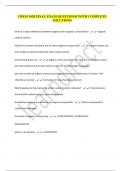
-
CHEM 1020 FINAL EXAM QUESTIONS| WITH COMPLETE SOLUTIONS
- Exam (elaborations) • 17 pages • 2024
-
- $9.99
- + learn more
CHEM 1020 FINAL EXAM QUESTIONS| WITH COMPLETE SOLUTIONS what is a major difference between organic and inorganic compounds? - -organic contain carbon what is the reason why there are so many organic compounds? - -carbon atoms can form stable covalent bonds with other carbon atoms functional groups are - -to organic chem as polyatomic ions are to inorganic chem, are chemically bound to each other in order to develop larger molecules the vast number of organic compounds is due to the uniqu...
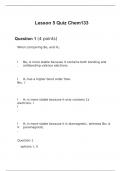
-
CHEM133 Week 11 Lesson 5 Quiz
- Exam (elaborations) • 17 pages • 2023
- Available in package deal
-
- $29.99
- + learn more
1. Question: When comparing Be2 and H2: 2. Question: Atoms that are sp2 hybridized form ____ pi bond(s). 3. Question: The hybridization of the nitrogen atom in the cation NH2+ is: 4. Question: Which one of the following molecules has an atom with an incomplete octet? 5. Question: Nitrous oxide (N2O) is sometimes called "laughing gas". What is the formal charge on the central nitrogen atom in the most favorable Lewis structure for nitrous oxide based on minimizing formal charge overall? 6....
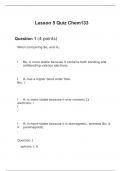
-
CHEM133 Week 11 Lesson 5 Quiz
- Exam (elaborations) • 17 pages • 2023
- Available in package deal
-
- $29.99
- + learn more
1. Question: When comparing Be2 and H2: 2. Question: Atoms that are sp2 hybridized form ____ pi bond(s). 3. Question: The hybridization of the nitrogen atom in the cation NH2+ is: 4. Question: Which one of the following molecules has an atom with an incomplete octet? 5. Question: Nitrous oxide (N2O) is sometimes called "laughing gas". What is the formal charge on the central nitrogen atom in the most favorable Lewis structure for nitrous oxide based on minimizing formal charge overall? 6....
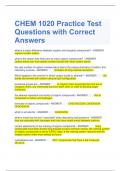
-
CHEM 1020 Practice Test Questions with Correct Answers
- Exam (elaborations) • 12 pages • 2023
-
Available in package deal
-
- $14.39
- + learn more
CHEM 1020 Practice Test Questions with Correct Answers what is a major difference between organic and inorganic compounds? - ANSWER organic contain carbon what is the reason why there are so many organic compounds? - ANSWER carbon atoms can form stable covalent bonds with other carbon atoms the vast number of organic compounds is due to the unique chemistry of carbon. this chemistry involves - ANSWER formation of long chains& isomerism Which applies to the m...
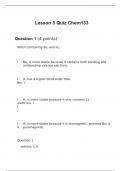
-
CHEM133 Week 11 Lesson 5 Quiz Questions and Answers APU
- Exam (elaborations) • 17 pages • 2023
- Available in package deal
-
- $23.99
- + learn more
1. Question: When comparing Be2 and H2: 2. Question: Atoms that are sp2 hybridized form ____ pi bond(s). 3. Question: The hybridization of the nitrogen atom in the cation NH2+ is: 4. Question: Which one of the following molecules has an atom with an incomplete octet? 5. Question: Nitrous oxide (N2O) is sometimes called "laughing gas". What is the formal charge on the central nitrogen atom in the most favorable Lewis structure for nitrous oxide based on minimizing formal charge overall? 6....
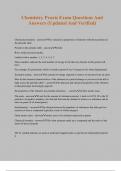
-
Chemistry Praxis Exam Questions And Answers (Updated And Verified)
- Exam (elaborations) • 7 pages • 2024
-
- $11.49
- + learn more
Chemistry Praxis Exam Questions And Answers (Updated And Verified) Chemical periodicity - answerThe variation in properties of elements with their positions in the periodic table Periods in the periodic table - answerPeriods: Rows which run horizontally. Labeled with a number: 1, 2, 3, 4, 5, 6, 7. These numbers indicate the total number of energy levels that any element in this period will have. For example, K (potassium) which is found in period 4, has 4 energy levels when diagrammed. ...
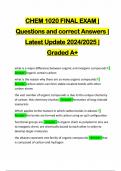
-
CHEM 1020 FINAL EXAM | Questions and correct Answers | Latest Update 2024/2025 | Graded A+
- Exam (elaborations) • 17 pages • 2024
- Available in package deal
-
- $12.99
- + learn more
CHEM 1020 FINAL EXAM | Questions and correct Answers | Latest Update 2024/2025 | Graded A+ what is a major difference between organic and inorganic compounds? - Answer -organic contain carbon what is the reason why there are so many organic compounds? - Answer -carbon atoms can form stable covalent bonds with other carbon atoms the vast number of organic compounds is due to the unique chemistry of carbon. this chemistry involves - Answer -formation of long chains& isomerism Which app...
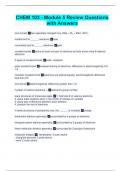
-
CHEM 103 - Module 5 Review Questions with Answers
- Exam (elaborations) • 2 pages • 2024
-
Available in package deal
-
- $8.99
- + learn more
ionic bonds two oppositely charged ions (2Na + Cl₂ = 2Na⁺+2Cl⁻) metals tend to ______ electrons lose nonmetals tend to ______ electrons gain covalent bonds share at least one pair of electrons so both atoms have 8 valence electrons 2 types of covalent bonds polar, nonpolar polar covalent bond unequal sharing of electrons, difference in electronegativity 0.5-1.6 nonpolar covalent bond electrons are shared equally, electronegativity difference less than 0.5 ionic bond el...

Do you wonder why so many students wear nice clothes, have money to spare and enjoy tons of free time? Well, they sell on Stuvia! Imagine your study notes being downloaded a dozen times for $15 each. Every. Single. Day. Discover all about earning on Stuvia


